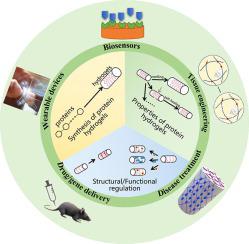Chemical Engineering Journal ( IF 13.3 ) Pub Date : 2022-08-06 , DOI: 10.1016/j.cej.2022.138494 Qian Zhang , Yue Liu , Guozheng Yang , Hao Kong , Lei Guo , Gang Wei

|
具有三维网络结构的蛋白质水凝胶可以通过蛋白质单体和组装体的共价和非共价交联来合成,由于其低毒性、更高的生物相容性、更好的生物活性和更好的柔韧性,在各个领域都显示出广泛的应用。传统的无机和聚合物水凝胶。在这篇综述中,我们介绍了蛋白质水凝胶的合成、结构和功能调控以及医疗保健应用方面的最新进展(2016 年至今)。我们提供了有关通过化学、物理和生物刺激合成蛋白质水凝胶的详细信息,然后介绍了它们独特的自愈、刺激响应、溶胀、机械、生物和可注射特性。此外,我们分析了可用于通过定制卷曲螺旋、多孔和周期性结构以及在蛋白质水凝胶中添加各种功能材料来调节蛋白质水凝胶的结构和功能的策略。最后,展示和讨论了基于蛋白质的水凝胶在可穿戴设备、生物传感器、药物/基因传递、疾病治疗、组织工程、癌症治疗和生物成像方面的医疗保健应用。这是首次展示蛋白质水凝胶对医疗保健领域的卓越贡献,对于读者合理设计和合成功能性生物水凝胶以及进一步开发用于先进应用的新型水凝胶具有重要价值。和周期性结构,以及在蛋白质水凝胶中添加各种功能材料。最后,展示和讨论了基于蛋白质的水凝胶在可穿戴设备、生物传感器、药物/基因传递、疾病治疗、组织工程、癌症治疗和生物成像方面的医疗保健应用。这是首次展示蛋白质水凝胶对医疗保健领域的卓越贡献,对于读者合理设计和合成功能性生物水凝胶以及进一步开发用于先进应用的新型水凝胶具有重要价值。和周期性结构,以及在蛋白质水凝胶中添加各种功能材料。最后,展示和讨论了基于蛋白质的水凝胶在可穿戴设备、生物传感器、药物/基因传递、疾病治疗、组织工程、癌症治疗和生物成像方面的医疗保健应用。这是首次展示蛋白质水凝胶对医疗保健领域的卓越贡献,对于读者合理设计和合成功能性生物水凝胶以及进一步开发用于先进应用的新型水凝胶具有重要价值。和生物成像进行了演示和讨论。这是首次展示蛋白质水凝胶对医疗保健领域的卓越贡献,对于读者合理设计和合成功能性生物水凝胶以及进一步开发用于先进应用的新型水凝胶具有重要价值。和生物成像进行了演示和讨论。这是首次展示蛋白质水凝胶对医疗保健领域的卓越贡献,对于读者合理设计和合成功能性生物水凝胶以及进一步开发用于先进应用的新型水凝胶具有重要价值。

"点击查看英文标题和摘要"





















































 京公网安备 11010802027423号
京公网安备 11010802027423号